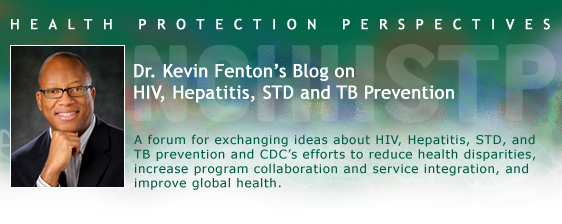 |

Wednesday
October 1
2008
5:00pm ET
by Kevin
Looking back — Forward thinking
Today marks the first day of the new fiscal year for
our programs. This is a time well suited to reflection
on what we’ve accomplished and a look forward to the
year ahead. So I would like to share with you some of my
thoughts on the past, present, and future of our work.
But first, I want to thank everyone who has posted comments. I have read them
all, and I very much appreciate your insight and creative thinking about how to
address the multitude of challenges in our area of public health. Although I
haven’t had the time to respond to specific comments, it is wonderful to see
that the blog is serving as a place where everyone can directly speak to each
other. I hope that you feel empowered to comment on each other’s contributions.
I value your feedback and gain much from your observations, so please continue
to post and comment as we continue to discuss HIV, hepatitis, STD and TB
prevention.
So – back to the year we’ve had: We achieved tremendous success and responded to
new challenges. We saw the lowest reports ever recorded for TB, and hepatitis A
and B, while AIDS reports and AIDS deaths have remained relatively stable (For a review of HIV/AIDS, hepatitis, STD, and TB surveillance data,
see the just released
2006 Disease Profile).
However, disease data and new research methods have identified areas that remain
a challenge. Specifically, the number of primary and secondary
syphilis cases
continue to increase, and new data highlighting the prevalence of
STDs in young
women and the
incidence of HIV in the United States confirm that these diseases
are more common than previously known.
Indications of turbulent times ahead for the U.S. and global economies may
have far-reaching impacts on our health protection efforts. As people
financially struggle in this environment, healthy behaviors may be less of a
priority, and tightening budgets could herald a scaling down of some effective
community prevention efforts. Now, more than ever, we will need to focus our
prevention efforts on the highest health impact activities, as well as on those
individuals without access to curative services, and those whose behaviors puts
them at highest risk.
We must also focus on the opportunities that lay ahead. Recent
congressional
support for global HIV and TB prevention and the expanded
national dialogue on
HIV and STDs underscore the significant impact of these diseases on the health
of those in the United States and around the world and the understanding that
national and global health are intertwined. This increased support and growing
dialogue around HIV, STD, TB, and viral hepatitis inspires me and I hope it
inspires you too to come together to improve the effectiveness of our programs
and use of our services.
In the next fiscal year, NCHHSTP will release new strategic plans and
undertake programmatic efforts that will continue to accelerate our progress. We
commit to completing a series of expert external reviews of our programs and to
listening, engaging, and interacting with our partners and the public as we
proceed. I will continue to blog about our progress.
As we start the new fiscal year, I ask for your input. What are your hopes
for the year ahead, and what opportunities can we make the most of to support
and accelerate our prevention efforts?
 Submit a comment -
Comment Policy Submit a comment -
Comment Policy

"We commit to completing a series of expert
external reviews of our programs and to
listening, engaging, and interacting with our
partners and the public as we proceed. I will
continue to blog about our progress.”
Dear Dr. Fenton:
I applaud the sentiment to deepen federal
agencies’ dialogue and planning with diverse
local, state, and national stakeholders. The
challenges we face are just too great to go it
alone. I urge you to take extra-ordinary steps
to involve community representations, especially
people living with HIV/AIDS, in external review
sessions, augmented by other means to garner our
input. These investments will help build support
for your programs and vision and give all of us
working to battle HIV/AIDS much valued context
in understanding your approaches. In the past,
community advocates have been afforded just a
few days notice—at best—before new CDC policy or
data is released. As you can well appreciate,
this is insufficient time to have any meaningful
role in comprehending and/or supporting the
newly released information, much less offering
input.
Best,
David Ernesto Munar
Vice President, Policy & Communications
AIDS Foundation of Chicago
and Board President, National Association of
People with AIDS (NAPWA)
Received from David Ernesto Munar, on
Monday,
October 20,
2008 at 12:35 pm ET
 Comment
Comment
 Dr. Fenton,
Dr. Fenton,
I underscore some of the points made and hope
that as we move forward, CDC will not continue
to fund the “National” organizations who have
forgotten about the “Local” need to work and
stem the tide of this epidemic. While our
politicians are showing why it’s not good to
bail out Wall Street (i.e. big businesses), I
want to also underscore why the CDC should
continue to fund the fat cats without some clear
examples and concrete plans on how their work
will reduce HIV infection. We’re too far into
this to allow organizations that have political
ties to continue to be funded. I appeal to the
CDC to strategically fund organizations in the
new round of CBA dollars and insist that they
show progress quarterly or risk being de-funded
or experience reduced funding. I don’t think we
can afford another 3 – 5 years of national
failure with some of these projects.
LaMont “Montee Jamal” Evans,
Chief Executive Officer
Healthy Black Communities, Inc.
Received from LaMont Evans, on Thursday,
October 2,
2008 at 4:22 pm ET
 Comment
Comment
Last
Modified:
12/11/2008
Last Reviewed: 09/03/2008
Content Source:
National Center for HIV/AIDS, Viral
Hepatitis, STD, and TB Prevention |
![]()